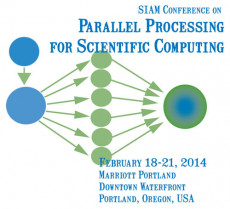CRD, NERSC Staff Present at SIAM Conference on Parallel Processing for Scientific Computing
February 18, 2014
Dozens of scientists from Berkeley Lab’s Computational Research and National Energy Research Scientific Computing divisions are presenting their research this week at the Sixteenth Conference on Parallel Processing for Scientific Computing. Sponsored by the Society for Industrial and Applied Mathematics, the conference series has played a key role in promoting parallel scientific computing, algorithms for parallel systems and parallel numerical algorithms. The conference is unique in its emphasis on the intersection between high performance scientific computing and scalable algorithms, architectures, and software. This year’s meeting is being held Feb. 18-21 in Portland, Ore. Lenny Oliker of CRD’s Future Technologies Group was a member of the organizing committee.
Here is a day-by-day list of papers with authors from Berkeley Lab in bold:
Tuesday, Feb. 18
- “Performance Modeling for Tiling with PIN,” John Bachan, Didem Unat, Cy Chan and John Shalf, CRD. abstract
Wednesday, Feb. 19
- “Hardware Support for Collective Data Transfers,” John Shalf and Georgios Michelogiannakis, CRD. abstract
- “ Programming Model Support for Tiling,” Didem Unat, CRD. abstract
- “A Hybrid MPI/openmp 3D FFT Implementation for Parallel Plane Wave First-Principles Materials Science Codes,” Andrew Canning, CRD. abstract
- “Avoiding Synchronization in Geometric Multigrid,” Erin C. Carson and Nicholas Knight, University of California,; Samuel Williams, Michael Lijewski and Ann S. Almgren, CRD; James Demmel, University of California, Berkeley and CRD. abstract
- “Communication Optimal Loop Nests,” Michael Christ, James W. Demmel and Nicholas Knight, University of California, Berkeley, Thomas Scanlon, University of California, USA and; Katherine Yelick, CS. abstract
- “Performance Optimization of Block Eigensolvers for Nuclear Structure Computations,” H. Metin Aktulga, Sam Williams, Aydin Buluc, Chao Yang and Esmond G. Ng, CRD. abstract
- Aydin Buluc of CRD will participate in a panel discussion: "High-Performance Computing on Graphs."
Thursday, Feb. 20
- “Berkeleygw for Excited States Calculations,” Jack Deslippe, NERSC. abstract
- “New Development in Nwchem,” Bert de Jong, CRD. abstract
- “Challenges and Opportunities in Extreme-Scale Application Software Productivity,” Lois C. McInnes, Argonne National Laboratory,; Jeffrey N. Johnson and Hans Johansen, CRD. abstract
- “High-performance and High-productivity Semantic Graph Analysis,” Aydin Buluc, CRD; John R. Gilbert and Adam Lugowski, University of California, Santa Barbara; Shoaib Kamil, Massachusetts Institute of Technology, USA; Leonid Oliker and Samuel Williams, CRD. abstract
- “What Krylov Basis Computation for GMRES on Cluster of Accelerators,” abstract
- Langshi Chen, CNRS, France; Serge G. Petiton, CNRS/LIFL and INRIA, France; Leroy A. Drummond, CRD; Maxime Hugues, LIFL, France
- “The Impact of Workload Strategies on a UPC-based CG,” Osni A. Marques, CRD; Jorge González-Domínguez, Mar'ia Mart'in, and Juan Tourino, University of A Coruña, Spain. abstract
- “Dynamic Parallel Algebraic Multigrid Coarsening for Strong Scaling,” Akihiro Fujii, Takuya Nomura, and Teruo Tanaka, Kogakuin University, Japan; Osni A. Marques, CRD. abstract
- “Parameter Selection and Prediction to Tune the Performance of Krylov Subspace Methods,” France Boillod-Cerneux, CNRS/LIFL, France; Leroy A. Drummond, CRD; Herve Galicher, CEA, France; Christophe Calvin, CEA Saclay, France; Serge G. Petiton, CNRS/LIFL and INRIA, France. abstract
- “Tuning Asynchronous Co-Methods for Large-scale Eigenvalue Calculations,” Nahid Emad, University of Versailles, France; Leroy A. Drummond, CRD; Miwako Tsuji and Makarem Dandouna, University of Versailles, France. abstract
- “Chombo-Crunch: High Performance Simulation of Pore Scale Reactive Transport Processes Associated with Carbon Sequestration,” David Trebotich, Mark Adams and Brian Van Straalen, CRD; Anshu Dubey, CRD, Terry J. Ligocki and Dan Graves, CRD. abstract
- “Fast Clustering Methods for Genetic Mapping in Plants,” Veronika Strnadova, University of California, Santa Barbara; Aydin Buluc and Leonid Oliker, CRD; Joseph Gonzalez and Stefanie Jegelka, University of California, Berkeley,; Jarrod Chapman, DOE Joint Genome Institute,; John R. Gilbert, University of California, Santa Barbara. abstract
- “Design of HACC for Extreme-Scale Simulation,” Hal Finkel, Salman Habib, Vitali Morozov, Adrian Pope, Katrin Heitmann, Kalyan Kumaran, Tom Peterka, and Joe Insley, Argonne National Laboratory; David Daniel and Patricia Fasel, Los Alamos National Laboratory, Nicholas Frontiere, Argonne National Laboratory and University of Chicago; Zarija Lukic, CRD. abstract
- John Shalf of CRD and James Demmel of UC Berkeley and CRD will be part of a discussion titled “Forward Looking Panel.”
Friday, Feb. 21
- “Rambutan: A Lightweight, Asynchronous Runtime for Simulation and Modeling, Cy Chan, CRD. abstract
- “Migrating the GTC-P Gyrokinetic Particle-in-Cell Code to Multicore and Manycore Systems,” Bei Wang, Princeton University; Stephane Ethier, Princeton Plasma Physics Laboratory; William Tang, Princeton University; Khaled Z. Ibrahim, CRD; Kamesh Madduri, Pennsylvania State University; Samuel Williams and Leonid Oliker, CRD. abstract
- “Compiler-Automated Communication-Avoiding Optimization of Geometric Multigrid,” Protonu Basu, University of Utah; Samuel Williams and Brian Van Straalen, CRD; Anand Venkat, University of Utah, Leonid Oliker,CRD; Mary Hall, University of Utah. abstract
- “Employing Random Butterfly Transformation in Sparse Direct Solvers,” Xiaoye S. Li and Francois-Henry Rouet, CRD; Marc Baboulin, INRIA/University of Paris-Sud, France. abstract
- “Designing Multifrontal Solvers Using Hierarchically Semiseparable Structures,” François-Henry Rouet and Xiaoye S. Li, CRD; Artem Napov, Université Libre de Bruxelles, Belgium. abstract
About Berkeley Lab
Founded in 1931 on the belief that the biggest scientific challenges are best addressed by teams, Lawrence Berkeley National Laboratory and its scientists have been recognized with 16 Nobel Prizes. Today, Berkeley Lab researchers develop sustainable energy and environmental solutions, create useful new materials, advance the frontiers of computing, and probe the mysteries of life, matter, and the universe. Scientists from around the world rely on the Lab’s facilities for their own discovery science. Berkeley Lab is a multiprogram national laboratory, managed by the University of California for the U.S. Department of Energy’s Office of Science.
DOE’s Office of Science is the single largest supporter of basic research in the physical sciences in the United States, and is working to address some of the most pressing challenges of our time. For more information, please visit energy.gov/science.










